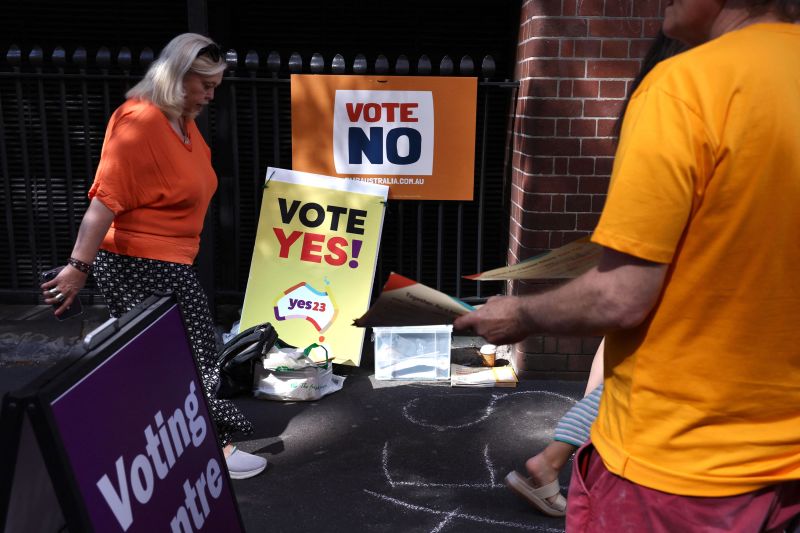
The Evolving Controversy of Australia Day

A deep dive into the evolving perspectives and controversies surrounding Australia Day, from the Indigenous mourning to the non-Indigenous celebrations, and the recent referendum outcome.
The Day of Mourning
As the sun rises on January 26th, a day marked as Australia's national day, a different sentiment fills the air for many Indigenous Australians. It is not a day of celebration, but rather a day of mourning, a day that symbolizes the colonial dispossession that occurred 236 years ago. The chants of Indigenous activist Gwenda Stanley echo through the streets, resonating with the crowd that stands in solidarity with the Indigenous community. The anger, the cheers, and the diverse faces in the crowd paint a picture of a nation divided on this controversial day.
Protesters carry the Aboriginal flag as Indigenous leaders speak about the injustices inflicted through colonization.
The deep-rooted sentiment is not confined to central Sydney; it reverberates across Australian cities, drawing attention to the increasing number of non-Indigenous Australians who find it difficult to partake in the festivities, knowing the significance of this day for their Indigenous fellow citizens. The Aboriginal flag waves high as Indigenous leaders address the injustices inflicted through colonization, and the voices of protest grow louder with each passing year.
A yacht sails in Sydney Harbor to mark Australia Day on January 16, 2024.
A Nation Divided
The divide becomes evident as voices from both sides express their perspectives on the national holiday. For some non-Indigenous Australians, the day represents summer fun, a time for celebration and relaxation. However, the growing awareness of Indigenous loss and the call for better outcomes have led to a shift in sentiment. The historical context of January 26th, the debate over the Voice to Parliament, and the rejection of the referendum proposal have intensified the cultural and political implications of the day, prompting a reevaluation of its significance.
Voters cast their referendum ballots in Melbourne on October 14, 2023.
The aftermath of the referendum has not only deepened the divide but also stirred political tensions, with attempts to leverage the controversy for political gain. The clash of opinions, the boycott calls, and the vandalism incidents reflect the heightened emotions and the underlying issues that overshadow the national holiday. Amidst all this, the mainstream debate has struggled to address the modern problems of Indigenous disadvantage, paving the way for the emergence of the Blak Sovereign Movement.
Voters are seen at a voting centre during The Voice referendum in West End, inner Brisbane, Australia, October 14, 2023. AAP Image/Jono Searle via REUTERS ATTENTION EDITORS - THIS IMAGE WAS PROVIDED BY A THIRD PARTY. NO RESALES. NO ARCHIVE. NEW ZEALAND OUT. NO COMMERCIAL OR EDITORIAL SALES IN NEW ZEALAND. AUSTRALIA OUT. NO COMMERCIAL OR EDITORIAL SALES IN AUSTRALIA
The Blak Sovereign Movement
In response to the challenges and limitations presented by the post-referendum discourse, the Blak Sovereign Movement has gained momentum among Indigenous communities. The movement embodies a declaration of empowerment, a refusal to seek rights from the settler population, and a commitment to self-governance. The rejection of the referendum by many proponents of Blak Sovereignty reflects a powerful statement of resilience and determination.
A Queen Victoria monument in Melbourne, Australia, is doused with red paint on January 25, 2024.
The 26th of January serves as a rallying point for the Indigenous community, not only to commemorate their losses but to assert their presence and identity. It is a day that signifies their unwavering spirit and their refusal to be assimilated. The movement represents a shift towards self-determination and a reclaiming of Indigenous agency in the face of historical injustices and ongoing struggles.
A woman walks past volunteers handing out voting brochures outside a voting centre in central Sydney on October 3, 2023. Early voting opened on October 3 across a swathe of Australia on a reform that would recognise Indigenous people in the 1901 constitution for the first time. (Photo by DAVID GRAY / AFP) (Photo by DAVID GRAY/AFP via Getty Images)












